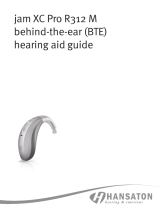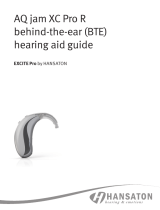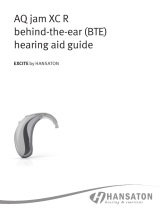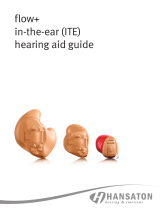Page is loading ...

resound.com
User guide
ReSound Behind-The-Ear hearing aids

Hearing aid information
Left hearing aid Right hearing aid
Serial number Serial number
Model number Model number
Battery type
£13 £ 675
Program Beep Description
1 One beep
2 Two beeps
3 Three beeps
4 Four beeps
2

Table of Contents
Introduction 5
Your hearing aid 6
How to get your hearing aid ready for use 8
How to place the hearing aids in your ears 15
How to remove the hearing aids from your ears 18
How to use your hearing aids 19
Direct Audio Input 25
Advanced options 28
How to clean and maintain your hearing aids 36
Wireless accessories 42
Tinnitus Management 44
3

Introduction
Thank you for choosing our hearing aids. We recommend that you use your hearing aids every day -
that way you will fully benefit from them.
NOTE: Read this booklet carefully before you start using your hearing aids.
Intended use
Generic air-conduction hearing aids are wearable sound-amplifying devices intended to
compensate for impaired hearing.The fundamental operating principle of hearing aids is to
receive, amplify, and transfer sound to the eardrum of a hearing impaired person.
For devices including a Tinnitus Sound Generator module:
The Tinnitus Sound Generator module is a tool to generate sounds to be used in a Tinnitus
Management Program to temporarily relieve patients suffering from Tinnitus.The target
population is primarily the adult population over 18 years of age.This product may also be used
with children 12 years of age or older.
5

Your hearing aid
Model 88
1. Earmold
2. Tube
3. Microphone openings
4. Program button
5. Volume control
6. Battery compartment
7. Left/Right identification
8. Manufacturer
4
5
6
1
2
3
7
8
6

Model 98
1. Earmold
2. Tube
3. Microphone openings
4. Program button
5. Volume control
6. Battery door lock
7. Battery compartment
8. Left/Right identification
9. Manufacturer
1
2
3
4
5
6
7
8
9
NOTE: You can find information on your hearing aid's serial number and model inside the
battery compartment.
7

How to get your hearing aid ready for use
Battery warnings
WARNING: Batteries contain dangerous substances and should be disposed of carefully in
the interest of your safety and for the environment. Please note:
1. Keep batteries away from pets, children and mentally challenged persons.
2. DO NOT place batteries in your mouth. Consult a physician immediately if a battery has
been swallowed, as they can be harmful to your health.
3. Do not attempt to recharge batteries (Zinc-Air) which are not specifically designated as
rechargeable because they may leak or explode.
4. DO NOT attempt to dispose of batteries by burning them.
5. Used batteries are harmful to the environment. Please dispose of them according to
local regulations or return them to your hearing care professional.
6. To save battery power, turn your hearing aids off when they are not in use.
WARNING: Batteries may leak. Remove the battery if you leave the hearing aids unused for
longer periods.
8

WARNING: If the batteries are not inserted correctly, the device will not work and the
batteries may build up heat. If this happens, please remove the batteries.
NOTE: Always use new Zinc-Air batteries that have a minimum remaining shelf life of one
year.
9

How to replace the battery
1. Prepare the new battery.
Remove the protective foil to
activate the battery - wait for 2
minutes before inserting the
battery into the hearing aid.
2. Open the battery door
completely by using your
fingernail.
3. Remove the used battery.
4. Insert the new battery
with the positive side (+)
facing upwards. Always
insert the battery in the
door, never directly into
the hearing aid.
5. Close the battery door.
10

Please observe the following:
1. To save battery power, turn off your hearing aids when they are not in use.
2. At night, switch off the hearing aid and open the battery door completely to allow moisture to
evaporate. This prolongs the hearing aid's lifespan.
3. If the hearing aid frequently loses connection with wireless accessories, contact your hearing
care professional for a list of appropriate batteries.
Battery door lock
If the hearing aid is going to be used by a child or a person with a mental disability, you can ask your
hearing care professional to make a battery door lock available for you. You can turn the hearing
aid on and off as you usually do, but you will have to unlock the battery door every time you need to
change the battery.
11

How to use the battery door lock
For Model 88:
To lock the battery door:
1. Open the battery door to the OFF position. 2. Use the tool provided with your battery door
lock to push the slider from the left side to
the right side.
To unlock the battery door simply repeat the same procedure but pushing the slider to the right
instead. You can now change the battery as described in “How to change the battery”.
12

For Model 98:
To lock the battery door:
1. Insert the tool straight into the battery door
lock.
2. Slide lock to the left. An indication mark
shows that the battery door is in the locked
position (you will be able to see a white dot).
To unlock the battery door simply repeat the same procedure but pushing the slider to the right
instead. You can now change the battery as described in “How to change the battery”.
Low battery warning
When the batteries are low on power, your hearing aids reduce the volume, and play a melody
every 15 minutes until they are completely drained and turn off.
13

Low battery indicator when paired with wireless accessories (optional)
The batteries drain faster when you use wireless functionalities like direct streaming from your
smartphone or streaming sound from your TV with our TV Streamer. When the batteries deplete,
the support of some wireless accessories shuts down. Full functionality returns when you insert a
new battery. The table below shows how the functionality decreases with the depletion of the
batteries.
Battery level Signal Hearing aid Remote control Streaming
Fully charged
P P P
Low
P P
x
Depleted (change
battery)
P
x x
14

How to place the hearing aids in your ears
How to tell left from right
If you have two hearing aids, they may be tuned differently. One for your left ear, the other for
your right. Do not swap them. Please pay attention to this when cleaning, storing and inserting the
hearing aids.
You might want to ask your hearing care practitioner to mark your hearing aids with a colored left
and right indication: blue for left and red for right.
15

How to insert the earmold in your ear
1. Hold the earmold between
your thumb and index
finger and position its
sound outlet in your ear
canal.
2. Slide the earmold all the
way into your ear with a
gentle, twisting
movement.
3. Turn the top part of the
earmold gently backwards
and forwards so it tucks
behind the fold of skin
above your ear canal. Move
the earmold up and down
and gently press it to place
it correctly in the ear.
4. Place the hearing aid firmly
behind the ear and make
sure it sits securely.
NOTE: It may be helpful to pull your ear up and outward with your opposite hand during
insertion. By experimenting, you may discover an easier method.
16

CAUTION: Never attempt to modify the shape of the hearing aid, earmolds or tubing
yourself.
17

How to remove the hearing aids from your ears
1. Lift the hearing aid from behind the ear.
2. Using your thumb and index finger, take hold of the earmold (not the hearing aid or the
tubing).
3. Gently twist and pull the earmold to remove it from the ear.
18

How to use your hearing aids
How to adjust the volume
Your hearing aid automatically adjusts the volume depending on your listening situation.
However, if your hearing aid has a volume control, you can adjust the volume according to your
preferences.
1. To increase the volume, press the top part of the volume
control
2. To decrease the volume, press the bottom part of the volume
control
When you change the volume, the hearing aid responds with a beep. When you reach the upper or
lower limits, the hearing aid responds with a low-pitched beep.
Your hearing aid can be programmed with an additional function for the volume control on "down
button long press":
19

• Minimum volume: volume will immediately reduce to lowest setting, or
• Mute: the hearing aid will be muted.
To resume normal volume, "down button long press".
NOTE: If you have two hearing aids with the Synchronized Volume Control function enabled,
volume control adjustments to one hearing aid automatically repeat in the second hearing
aid. When you change the volume in one of the hearing aids, it responds with one or more
beeps. A beep in the second hearing aid follows.
NOTE: Your hearing care professional can disable the volume control or replace it with a
non-functional cover.
How to change program
Your hearing aid has a push button which allows you to select from several listening programs.
Push the button to change program. You will then hear one or more
beeps. The number of beeps indicates which program you have
selected (one beep = program one, two beeps = program two and
so on).
You can also change programs using our wireless acessories and smartphone apps.
20
/





